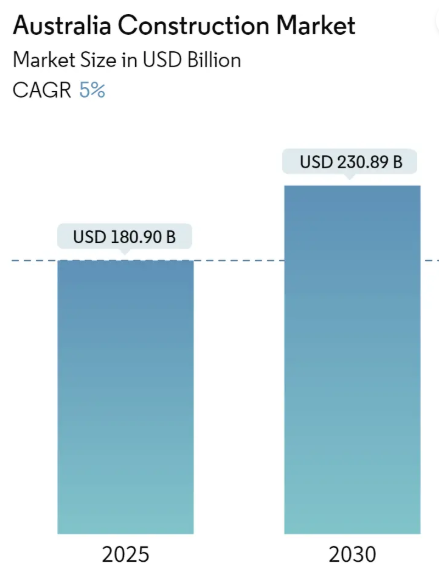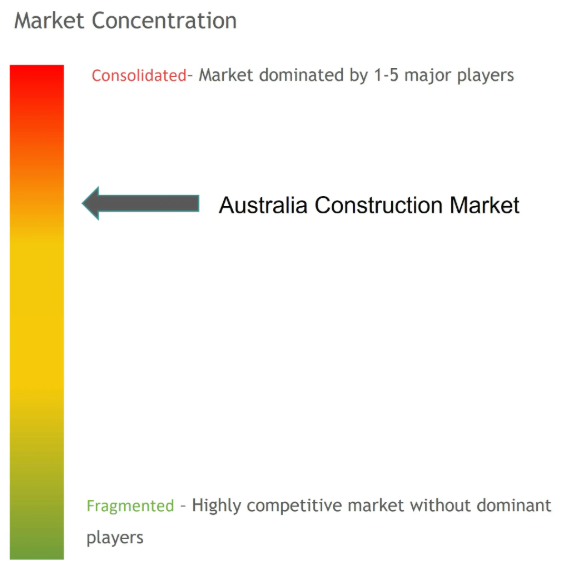Construction Industry in Australia Size & Share Analysis – Growth Trends & Forecasts (2025 – 2030)
The Construction Industry in Australia is Segmented by Sector (Residential, Commercial, Industrial, Infrastructure (Transportation), Energy, and Utilities). The Report Offers Market Sizes and Forecasts in Value (USD) for all the Above Segments.
Construction Industry in Australia Size & Share Analysis – Growth Trends & Forecasts (2025 – 2030)
Australia Construction Market Size
| Study Period | 2020 – 2030 |
| Base Year For Estimation | 2024 |
| Forecast Data Period | 2025 – 2030 |
| Market Size (2025) | USD 180.90 Billion |
| Market Size (2030) | USD 230.89 Billion |
| CAGR (2025 – 2030) | 5.00 % |
| Market Concentration | Low |
Major Players
*Disclaimer: Major Players sorted in no particular order |

Compare market size and growth of Australia Construction Market with other markets in Real Estate and Construction Industry
Australia Construction Market Analysis
The Australia Construction Market size is estimated at USD 180.90 billion in 2025, and is expected to reach USD 230.89 billion by 2030, at a CAGR of 5% during the forecast period (2025-2030).
The huge investment flowing in the industry is driving the market. Furthermore, the industry is being driven by technological innovation and demand for prefabricated buildings.
- The outlook for investment remains positive. A large pipeline of residential and non-residential projects is expected to sustain construction activity for at least the next year. However, the recent flow of data and information from the Bank’s liaison program indicate that capacity constraints have intensified in some sectors, which will limit the pace of growth in construction activity for some time. The pipeline of private non-residential construction work yet to be done increased recently, reflecting additional commercial projects. By contrast, the outlook for dwelling investment has been downgraded. Demand for new detached dwellings is expected to be soft as a further decline in established housing prices and high construction costs reduce the incentive to build new dwellings. Prospects for higher-density residential projects are brighter, as rental vacancy rates in Sydney and Melbourne have declined and the population growth recovers following the reopening of the international border.
- The Australian construction industry generates nearly 360 billion in revenue (9% of the country’s Gross Domestic Product (GDP)) and has a projected annual growth rate of 2.4%. As of November 2021, the construction industry employed approximately 1,143,600 people. It employs approximately one in 10 workers, and this constitutes 8.7% of the total workforce. According to the construction industry statistics for the five years to November 2021, employment in the industry increased by 7.3%. The Australian Industry and Skills Committee states that although employment declined in 2020 and 2021, projections indicate that it will reach 1,263,900 by 2025. However, more optimistic predictions indicate an employment growth of 6.8% by November 2025.
- The Australian government has a strong vision for developing smarter communities powered by cutting-edge technology solutions. Digital transformation has been placed at the heart of the government’s economic strategy. New technologies in the construction industry are disrupting traditional models for planning, staffing, monitoring, and delivering projects as the physical world becomes increasingly digitized. Despite the obvious benefits, the construction industry is one of the slowest in the world to adopt new technologies and has had lower productivity gains compared to other sectors, such as manufacturing. Startups play an important role in digitizing the construction business. Investors are also interested in the possibilities they offer.
- The sudden arrival of new buildings is altering the skylines. These new constructions are partially a result of prefabricated construction marvels, which allow for the production of big components off-site, shipping them to the construction site, and assembling them more quickly than would be possible with traditional bricklaying or other methods. Prefabrication combines manufacturing and building, resulting in a solution that combines the advantages of lower labor costs with high-quality output because the majority of prefabricated structures are created off-site in a tightly regulated environment. The knock-on impact of prefabrication may result in reduced mortgages, more homeowners, and reasonably priced rents by minimizing the cost of labor, materials, and site hours.
Australia Construction Market Trends
Increase in Non-Residential and Infrastructure Construction
Commercial building has been one of the strong contributing factors to the construction sector of Australia over the last couple of years and has recently reached new heights in terms of volume. In contrast to the residential building market, the value of construction in the non-residential segment has continued to grow. The investments in the non-residential sectors were focused on schools, hospitals, offices, warehouses, and hotels.
Since the Reserve Bank of Australia has promised to keep interest rates low for at least the next three years, it is estimated that construction costs would also remain low in 2023. According to industry experts and studies, the boom in non-residential construction in Australia has come to an end and will exhibit a negative growth rate for at least the next few years.
Australia has many country-owned EPC (engineering, procurement, construction) groups, which are well-established in the mining-related engineering construction sector. Major UK and US EPC companies that have long had a presence in the market include Bechtel, Fluor, Balfour & Beatty, and Laing O’Rourke. Commercial construction has been a star performer over the last couple of years; however, such above-average growth is expected to fall back to normal levels in the forecast period. Office buildings, education, and accommodation will contract significantly, and transportation, health, and retail will have more favorable projections. With government-led projects in the energy sector and transportation ramping up, the construction industry is optimistic about seeing a growth rate during the forecast period.

Increasing Prefabricated Housing In Australia Driving The Construction Sector
Prefabricated housing is mainly driven by the demand for low to mid-rise residential buildings, project homes, and public housing. Increasing awareness about prefabricated building benefits, such as reduced material waste and less disruption to the surrounding environment, is driving market growth. Revenue in the prefabricated building industry is expected to grow as the rising demand from the government and education sectors has supported the industry during the COVID-19 pandemic. Furthermore, the Australian construction industry has faced severe challenges over the past two decades.
High-quality, lightweight, prefabricated modular systems are expected to contribute to housing stock with excellent amenities for occupants at a substantially lower cost when compared with traditional housing. With Australia’s population growth expected to see a 60% increase to 37.6 million people by 2050, the industry needs to look to more cost-effective and well-designed inner-city developments at higher densities. Prefabricated housing is a next-generation housing construction industry, a game-changer in the cost of housing, competitiveness, efficiency, and productivity.
Prefabricated building systems and construction hold a high potential to improve the efficiency and performance of the Australian construction industry in a more sustainable sense. With the market just opening up in the building industry, generating trust and investments in the technology, the market is open to ample opportunities and can witness strong growth in the coming years.

Australia Construction Industry Overview
The Australian construction market is partially consolidated and highly competitive, with a few players occupying the major share. In terms of private companies, the Lendlease Group and CIMIC Group are two of the biggest names in Australia’s construction industry. Major players in the market are moving toward innovation and digitalization. Explore, a new global technology company of the CIMIC Group, is jointly undertaking a series of research projects, partnering with MIT and IBM, contributing to the research and development of artificial and augmented intelligence related to the construction industry. Australia has numerous home-grown EPC (engineering, procurement, creation) groups that are mainly well set up within the mining-associated engineering creation sector. However, a number of them additionally have massive distant places undertaking experience.
Australia Construction Market Leaders
- Laing O’Rourke
- Hutchinson Builders
- CPB Contractors
- Lendlease Corporation
- CIMIC Group
- *Disclaimer: Major Players sorted in no particular order

Australia Construction Market News
- May 2023: New office of the Indonesia-Australia partnership for Infrastructure (KIAT) was opened by the Australian ambassador to Indonesia, Penny Williams (PSM), and minister of public works and housing of the Republic of Indonesia, Basuki Hidayat.
- July 2022: Laing O’Rourke entered into a strategic partnership with Robotics Australia Group, a leading agency in the robotics sector in Australia. This partnership is anticipated to explore how current and emerging robotics technologies can address key challenges in the construction sector, including productivity, labor shortages, and safety.
- April 2022: Thiess, a CIMIC Group company, entered into a business cooperation agreement to provide mine design and engineering services to Tata Steel. As part of the deal, Thiess is expected to work with Tata Steel to provide competitive integrated business solutions to the global mining industry. Tata Steel is one of the world’s most geographically diverse steel producers, offering a fully integrated steel business from mining to manufacturing to finished product marketing.

